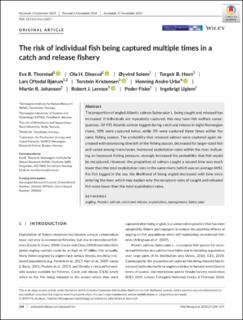The risk of individual fish being captured multiple times in a catch and release fishery
Thorstad, Eva Bonsak; Diserud, Ola Håvard; Solem, Øyvind; Havn, Torgeir Børresen; Bjørum, Lars Rasmus Oftedal; Kristensen, Torstein; Urke, Henning Andre; Johansen, Martin Rognli; Lennox, Robert J.; Fiske, Peder; Uglem, Ingebrigt
Peer reviewed, Journal article
Published version
Permanent lenke
https://hdl.handle.net/11250/2656396Utgivelsesdato
2019Metadata
Vis full innførselSamlinger
Originalversjon
Thorstad, E. B., Diserud, O. H., Solem, Ø., Havn, T. B., Bjørum, L. O., Kristensen, T., Urke, H. A., Johansen, M. R., Lennox, R. J., Fiske, P. & Uglem, I. (2019). The risk of individual fish being captured multiple times in a catch and release fishery. Fisheries Management and Ecology. 27(3), 248-257. doi: 10.1111/fme.12407Sammendrag
The proportion of angled Atlantic salmon Salmo salar L. being caught and released has increased. If individuals are repeatedly captured, this may have fish welfare consequences. Of 995 Atlantic salmon tagged during catch and release in eight Norwegian rivers, 10% were captured twice, while 3% were captured three times within the same fishing season. The probability that released salmon were captured again decreased with decreasing time left of the fishing season, decreased for larger‐sized fish and varied among rivers/years. Increased exploitation rates within the river, indicating an increased fishing pressure, strongly increased the probability that fish would be recaptured. However, the proportion of salmon caught a second time was much lower than the total exploitation rates in the same rivers (which was on average 46%). For fish tagged in the sea, the likelihood of being angled decreased with time since entering the river, which may explain why the recapture rates of caught and released fish were lower than the total exploitation rates.

